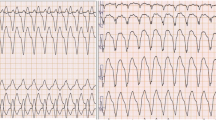Summary.
Background: Monomorphic tachycardia with an epicardial site of the arrhythmic focus in the left ventricular outflow tract (LVOT) usually cannot be ablated by an endocardial approach. We describe the use of cooled tip catheter ablation through the aortic sinus of valsalva to treat LVOT tachycardia. Methods: In seven patients (four males, one with valvular cardiomyopathy, six patients without heart disease) with sustained and non-sustained ventricular tachycardia (VT) an epicardial focus of LVOT tachycardia could be identified by pace-mapping and earliest local activation within the aortic sinus of valsalva. Coronary angiography served to define the position of the coronary arteries with respect to the ablation catheter. High frequency current was delivered using a closed-loop cooled tip catheter system (Chilli Cool®, Boston Scientific). ECG, Holter-ECG, echocardiography and transesophageal echocardiography were performed after the procedure and 3 months later. Results: Foci were located in the left (two patients), in the right (three) and in the acoronary aortic sinus (two). Successful ablation could be achieved in six patients. No procedure-related complications could be observed during a mean follow-up of 4.2 months. Conclusion: Monomorphic VT with epicardial origin in the LVOT can be successfully treated by cooled tip ablation through the aortic sinus of valsalva. The use of a cooled tip ablation system may be favourable in several ways: 1) it allows the creation of deep lesions necessary to reach remote foci; 2) due to lower temperatures at the catheter/tissue interface surface tissue damage may be reduced; 3) lower catheter temperature may additionally reduce the risk of local clot formation which is crucial for all left-sided procedures and especially for ablation in the sinus of valsalva.
Zusammenfassung.
Monomorphe ventrikuläre Tachykardien (VT) mit epikardialer Lage des Fokus im linksventrikulären Ausflusstrakt (LVOT) können meist nicht erfolgreich durch eine Katheterablation über einen endokardialen Zugang beseitigt werden. Wir beschreiben die Hochfrequenz (HF)-Stromkatheterablation epikardialer VT im LVOT mittels eines gekühlten Kathetersystems. Methoden: Durch differenziertes Mapping konnten bei sieben Patienten arrhythmogene Foci in den Sinus valsalvae der Aorta lokalisiert werden. Durch eine Koronarangiographie wurde die Lagebeziehung des Ablationskatheters zu den Koronararterien dargestellt. Die HF-Stromkatheterablation wurde unter Verwendung eines gekühlten Kathetersystems mit geschlossenem Spülkreislauf durchgeführt (Chilli Cool®, Boston Scientific). EKG, Langzeit-EKG, Echokardiographie und transösophageale Echokardiographie wurden am Folgetag und nach drei Monaten durchgeführt. Ergebnisse: Zwei Foci konnten im linken, drei im rechten und zwei im akoronaren Sinus valsalvae lokalisiert werden. Bei sechs der Patienten konnte die ventrikuläre Tachyarrhythmie erfolgreich beseitigt werden. Im Nachbeobachtungszeitraum traten keine Komplikationen auf. Folgerung: VT mit Lage des Fokus im LVOT können erfolgreich mittels eines gekühlten HF-Stromkathetersystems über die Sinus valsalvae der Aorta abladiert werden. Die Verwendung eines gekühlten Kathetersystems kann durch die größere Eindringtiefe, durch niedrigere Temperaturen an der Grenzfläche Katheter/Gewebe und die dadurch möglicherweise geringere Schädigung oberflächlichen Gewebes bei Katheterablationen in den Sinus valsalvae vorteilhaft sein.
Similar content being viewed by others
Author information
Authors and Affiliations
Additional information
Eingegangen: 11. März 2002 Akzeptiert: 21. Mai 2002
Correspondence to K. Kurzidim
Rights and permissions
About this article
Cite this article
Kurzidim, K., Neumann, T., Vukajlovic, D. et al. Gekühlte HF-Stromkatheterablation epikardialer Ausflusstrakttachykardien über die Sinus valsalvae der Aorta. Z Kardiol 91, 796–805 (2002). https://doi.org/10.1007/s00392-002-0839-6
Issue Date:
DOI: https://doi.org/10.1007/s00392-002-0839-6




